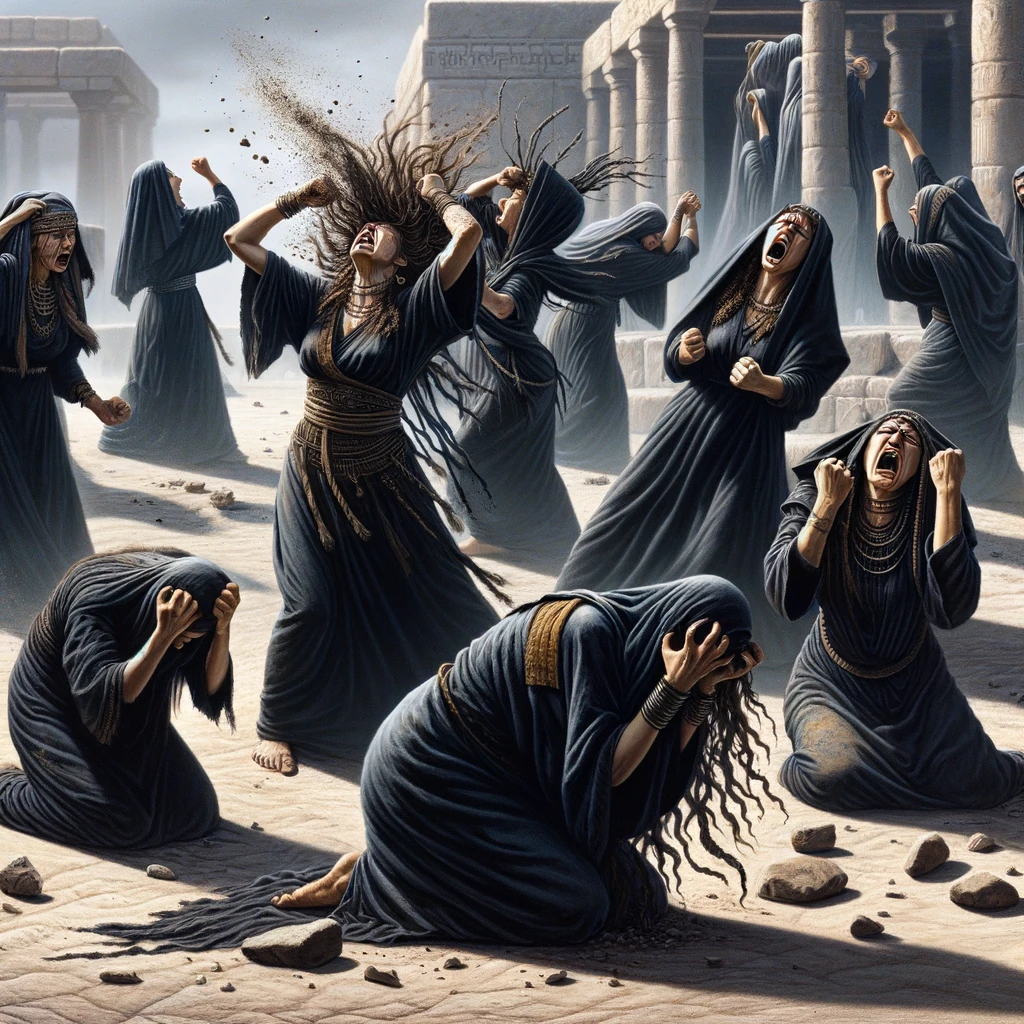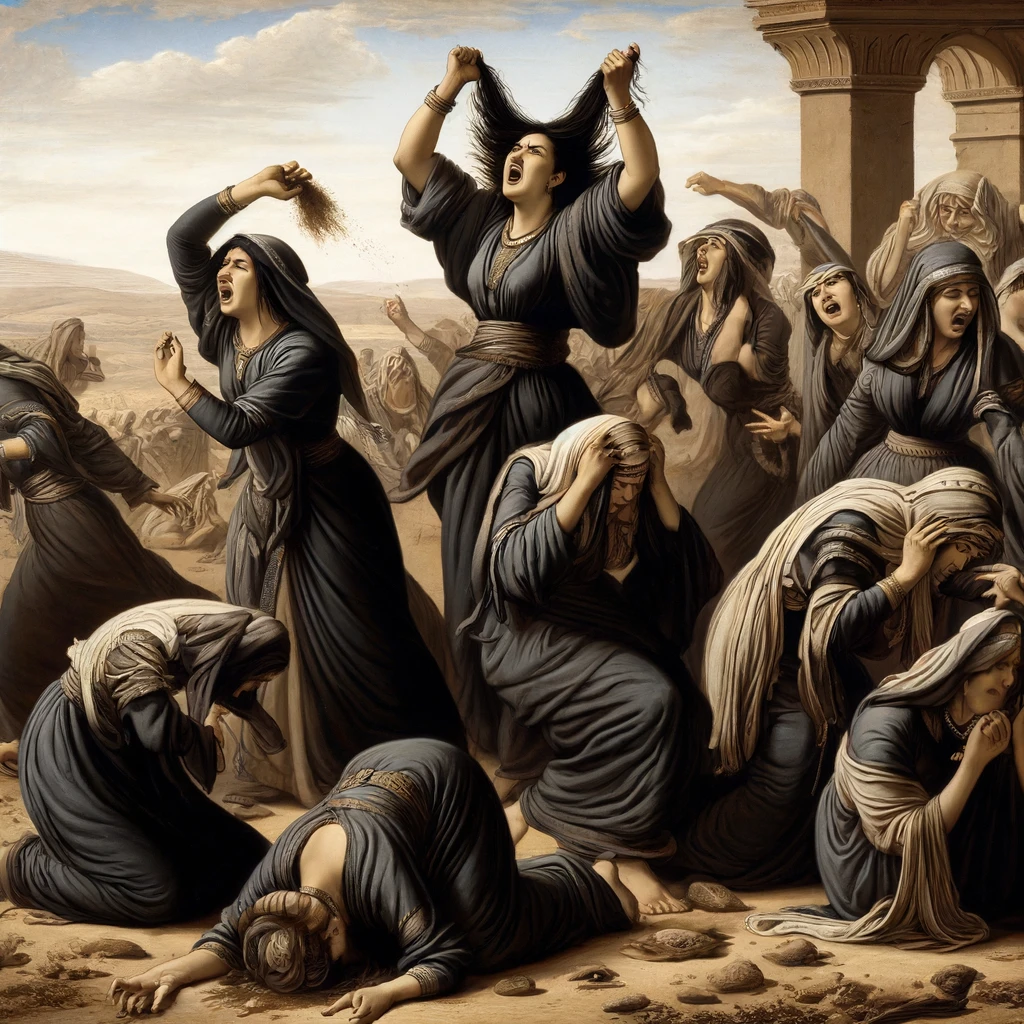The late questionably great comedian Andy Kaufman, apart from his iconic role as Latka on Taxi, spent his days devising comedy routines that played the audience for fools. His manager once asked him, (I paraphrase) “Who are you trying to entertain, the audience or yourself?”
This might describe this discussion on the disconnect between the origins of biblical mourning rituals and their practice in the pages of Scripture. I’m entertained by contemplating it even if you aren’t… at first… so just trust me that it does have an important benefit for you in the end.
I’m assuming here that you are aware of the fact that People in the Bible and people surrounding those in the Bible grieved rather violently, tearing their clothes, placing ashes or dirt on their heads, plucking out hair, and cutting themselves.
This is strange to we who pride ourselves on keeping control of our emotions even in the most dire situations… unless someone steals our parking space… then all bets are off.
David tears his clothes over the loss of Jonathan and Saul, (2 Sam. 1:11) Abner, (2 Sam. 3:31) and Amnon (2 Sam. 13:31). So does Job over the loss of his children (Job 1:20), and Elisha over Elijah when he’s taken up in a whirlwind (2 Kings 2:12). War runners frequently announce loss with torn garments, (1 Sam. 4:12; 2 Sam. 1:2) and Joshua tore his clothes after the loss to Ai (Josh. 7:6). Sometimes men tore their garments at the threat of certain doom. Rueben tears his coat when he realizes that Joseph is gone from the pit where he stashed him, (Gen. 37:29) and all the brothers tear their garments when Benjamin is caught with Joseph’s “divination” cup (Gen. 44:13). Joshua and Caleb tear their garments at the words of the other ten spies (Num. 14:6), and Jephthah when the reality of his misspoken oath comes on the feet of his daughter our the door of his house (Judg. 11:35). Consider, also, the garment rending Hushai over David’s flight, (2 Sam. 15:32) of Ahab over the prophecy of Elijah, (1 Kings 21:27) of the king of Israel over the provocation involving Namaan, (2 Kings 5:7) and over cannibalism in his land (2 Kings 6:30). There is also the garment rending of Athaliah at her betrayal, (2 Kings 11:14) of Hezekiah at the words of Rabshakkah, (2 Kings 19:1) of Josiah at the words of the long lost and broken words of the law, (2 Kings 22:11) and finally of Ezra when he hears of the people’s violation of their renewed covenant with YHWH, even plucking out parts of his beard (Ezr. 9:3). Tamar rends her virgin garments when she is raped and ejected as a harlot from Amnon’s room (2 Sam. 13:19). Job’s friends tear their garments in the face of Job’s great pain (Job 2:12). The High Priest tears his garments at the “blasphemy” of Jesus declaring himself divine (Matt. 26:65), Paul and Barnabas when the people of Lycanonia mistake them for gods (Acts 14:14).
The common practice among the pagans of cutting themselves and even pulling out massive amounts of hair is, however, forbidden to the Hebrews. Leviticus 19:28 says, “Ye shall not make any cuttings in your flesh for the dead, nor print any marks upon you: I am the LORD.” Deuteronomy 14:1 goes further, saying, “Ye are the children of the LORD your God: ye shall not cut yourselves, nor make any baldness between your eyes for the dead.” This does not mean that all Israelites rejected these forbidden things, as Jeremiah makes plain in a predictive note over the lack of mourning over God’s enemies in the Land. It appears that even among the Israelites some took mourning rites all the way. Jeremiah 16:6-7 predicts, “Both the great and the small shall die in this land: they shall not be buried, neither shall men lament for them, nor cut themselves, nor make themselves bald for them: Neither shall men tear themselves for them in mourning, to comfort them for the dead.”
What I’m assuming you don’t know is that the rending of the garments, the plucking of hair and the cutting of oneself all originated with a yet more ancient practice of covenanting with the dead and not as some purely emotive expression of overwhelming grief, though I’m sure they felt such on occasion.
Early covenant making centered around the mutual exchange of stuff like food and clothing. Kalluveettil calls this a gift of one’s self.[1] In 1 Samuel 18, Jonathan’s soul is “knit” to David’s soul, and he comes to love David as he loves his own soul. Thus, Jonathan gives David all of his clothes, his outer-garment, undergarment, sword, bow and girdle. This act is introduced with the clause, “Then Jonathan and David made (literally cut) a covenant.”[2]
If two ate of the same thing they were deemed to be made one through the mutual sharing. Thus, eating meals together became one of the most basic forms of covenant making.
This is also the origins for the earlier noted mourning rituals. Men would tear their garments, and hair, and cut themselves to leave deposits of cloth, hair, and blood with the deceased to maintain covenant bonds beyond the grave.[3]
Here’s the kicker. While there is some suggestion that hair pulling and blood smearing of the dead retained some connection to this pagan practice, thus being forbidden to Israel, the tearing of garments seems to have disconnected itself from this symbolism.
If one thinks such disconnect cannot take place, think about this.
Shaking hands was originally an offering of peace and proof that a person was unarmed.
Driving on the left was originally designed to leave the right handed among us free to wield older weapons against potentially dangerous passersby. The switch to the right emerged with the invention of fire arms which made self-defensive right side travel better.
Covering your mouth when you yawn was used by various peoples to either keep parts of your soul from escaping or to prevent Satan from getting in, and later to keep from spreading the plague… whence also comes the practice of saying “God Bless You” to a sneezer.
The best man at weddings was designed in certain times as a co-kidnapper when pillaging neighboring villages for available women to marry, and, in other times, as a protective body guard against unhappy family, friends, or rival suiters.
Brides originally threw things like garters and bouquets because the sexually charged consummation of a marriage was believed to make the Bride and all her stuff good luck charms for those equally desirous of finding their man. By throwing parts, it protected the bride much the way throwing raw steaks might protect one from eager guard dogs.
Origins don’t always dictate meaning. THUS!!!!
Saying, “This or that Christmas celebration was originally a pagan attempt to blah blah blah” is no reason to reject its use today in our celebrations of the Birth of our Lord… same for Easter, Halloween, Valentine’s Day, and anything else whose common use has disentangled itself from its original meaning or use. (You might disagree with me about Halloween being disentangled, but the point is still valid.)
In the Bible, God Himself commands the rending of garments without any hint that the pagan roots are active in the act… though he forbids other acts whose pagan meaning is alive and well.
Think on this the next time you meet a believer with a tattoo (not me, but one of those horrible Satan worshiping ones that dares to come to church with you.)
[1] Paul Kalluveettil, Declaration and Covenant (Rome: Biblical Institute Press, 1982),12.
[2] Such a covenant seems to appear in the Iliad as well. As Glaucus and Diomed seek one another out for single combat, prior to the battle of their armies, each discovers in the other an old friendship obligation. They spring from their chariots, grasp hands, This is also a covenant ratification act (2 Kings 10:15ff, Ezra 10:19, Lam. 5:6, 2 Chron. 30:8). Kalluveettil, Declaration, 20-26. and exchange armor as a sign of their ties to one another. Though their armies fight, they swear that they will not harm one another. Robert Maynard Hutchins, ed. The Iliad of Homer The Odyssey (vol. 4 of Great Books of the Western World : trans. Samuel Butler; Chicago: Encyclopaedia Britannica, Inc., 1952), 212-235.
[3] W. Robertson Smith, Lectures on the Religion of the Semites (first series, the Fundamental Institutions, new ed. rev. London: A & C Black, 1894), 335.
Discover more from Biblical Literacy with Dr. Andrew D. Sargent
Subscribe to get the latest posts sent to your email.



